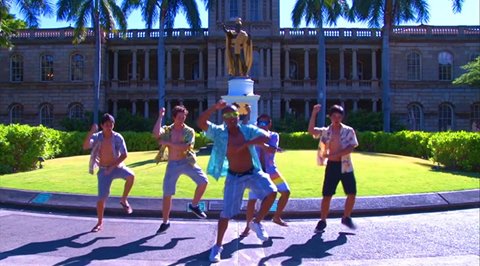
Below is an article from the Star Advertiser, for the original please visit StarAdvertiser.com
Hawaii's tourism industry is stepping up its marketing "Gangnam Style"?to attract the hip, urban and increasingly affluent Korean visitor market.
A silly parody of a Korean visitor prancing like a pony past sites at Waikiki Beach Walk, Ala Moana Beach Park and downtown Honolulu has gotten more than 25,000 views since PacRim Marketing Group, a marketing contractor for many Hawaii visitor industry clients, posted it Sept. 4 on YouTube.
The "Hawaii Style" video, which was created to promote Oahu in a fun and entertaining way, piggybacks on the success of the Korean hit "Gangnam Style," which launched in July and became an instant YouTube sensation. The song and music video by Park Jae-sang, known on stage as PSY, had garnered more than 4.8 million "likes" on YouTube views as of Friday. Earlier this year it earned a Guinness World Record for being the most-liked video in YouTube history. It is the second-most viewed video on YouTube with 628 million views as of Friday.
The success of "Gangnam Style" and the Hawaii parody is a positive sign for Hawaii's visitor industry, which has been aggressively trying to gain more traction in the Korean visitor market for decades. The popularity of the Hawaii video shows that the isles have cachet with young, affluent Korean visitors.
The original "Gangnam Style" video is both a celebratory nod to and spoof of Korea's recent economic success and improving demographics over the last 30 years. Gangnam, which was one of the least developed neighborhoods in Seoul in the early 1980s, has morphed into one of South Korea's most affluent and influential places.
"PSY popularized the Korean culture and became an icon," said Dave Erdman, president and CEO of PacRim Marketing Group. "It's amazing that a Korean YouTube video created in Korea would rank as the highest all-time YouTube video."
The goal of PacRim's MyHawaii media brand is to promote Hawaii to Asian travelers by providing news, entertainment and resources in their language and with an understanding of the cultural nuances of the market, said Kim Fujinaka, PacRim's integrated marketing and client services manager.
"Our media strategies are to connect and communicate on their terms,"?Fujinaka said. "Viral videos, memes and other social media trends are the way our audience is communicating today."?
Since Korea is one of the top IT countries in the world, with high computer, mobile and social media usage and dependence, the "Hawaii Style"?video spread virally through integrated online promotion — all in Korean language — via YouTube, Naver blogging, Facebook and PacRim's own MyHawaii.kr portal site for the Korean market, she said.
The new marketing push has built on advances that have been taking place since 2008, when Korea was added to the U.S. Visa Waiver Program. The continued strength of the Korean won relative to the dollar also has made an impact.
Korean visitors to Hawaii have grown by strong double digits since the visa waiver was implemented and more sophisticated marketing methods were introduced.
Hawaii welcomed 112,567 visitors from Korea in 2011 and is targeting 146,111 in 2012, said Grace Lee, Hawaii Tourism Authority tourism brand manager. Through the first eight months of this year, 96,096 Korean visitors had already come to Hawaii, Lee said.
Visitor demographics have also improved, said Conchita Malaqui, Waikiki Beach Walk general manager.
"Koreans have been coming to Hawaii for a long time, but we are seeing totally different visitors than before," Malaqui said. "Unlike their mothers and fathers and grandparents, conceptually in their minds, success is about being young, hip and cool. They are coming to Hawaii because they see it as an uber-chic, cool place to visit. They are active and they like to shop."?
Targeted efforts have been paying off since late 2011 and have made noticeable differences in the Korea visitor market this year, Malaqui said.
Elizabeth Churchill, senior vice president of sales and marketing for Aqua Hotels & Resorts, said the hotel chain has seen a recent uptick in travelers from Korea, especially young couples.
"We are seeing more romance and honeymoon travelers from Korea," Churchill said. "They tend to lean toward the Modern Honolulu because of the contemporary style of that resort. They like luxury."
Hawaii has gained huge attention in Korea as the leading long-haul destination for honeymoons, said Emily Kim, Hawaii Tourism Korea's marketing manager.
"They are paying over $3,000 and staying in five-star hotels," Kim said.
Indeed, HTA reported that Korean honeymooners accounted for 47.5 percent of total Korean visitors to Hawaii last year. Through the first six months of the year, Korean honeymooners were 17.8 percent ahead of the same period in 2011.
But it's not just the honeymooners who are falling in love with Hawaii, Churchill said. The Queen Kapiolani Hotel, which Aqua manages for a Korean ownership group, also gets a strong share of Korean business travelers, she said.
The good news is that Korean tourism to Hawaii is poised to grow even more, said John Jackson, vice president of marketing and sales for Korean Air, which owns the Waikiki Resort Hotel in Waikiki.
"I'm very, very bullish on Hawaii over the next four years," Jackson said.